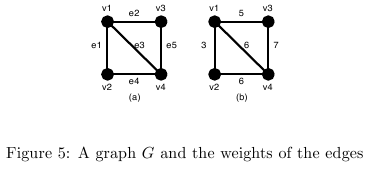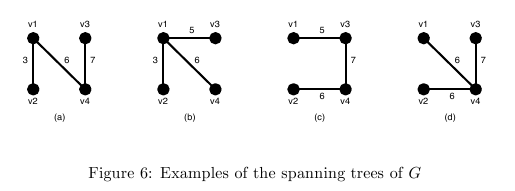Uva--1395(图论,MST)
2014-09-04 15:51:07
1395 - Slim Span
Time limit: 3.000 seconds
The graph G <tex2html_verbatim_mark>is an ordered pair (V, E) <tex2html_verbatim_mark>, where V <tex2html_verbatim_mark>is a set of vertices {v1, v2,..., vn} <tex2html_verbatim_mark>and E <tex2html_verbatim_mark>is a set of undirected edges {e1, e2,..., em} <tex2html_verbatim_mark>. Each edge e ![]() E <tex2html_verbatim_mark>has its weight w(e) <tex2html_verbatim_mark>.
E <tex2html_verbatim_mark>has its weight w(e) <tex2html_verbatim_mark>.
A spanning tree T <tex2html_verbatim_mark>is a tree (a connected subgraph without cycles) which connects all the n <tex2html_verbatim_mark>vertices with n - 1<tex2html_verbatim_mark>edges. The slimness of a spanning tree T <tex2html_verbatim_mark>is defined as the difference between the largest weight and the smallest weight among the n - 1 <tex2html_verbatim_mark>edges of T <tex2html_verbatim_mark>.
 <tex2html_verbatim_mark>
<tex2html_verbatim_mark>For example, a graph G <tex2html_verbatim_mark>in Figure 5(a) has four vertices {v1, v2, v3, v4} <tex2html_verbatim_mark>and five undirected edges {e1, e2, e3,e4, e5} <tex2html_verbatim_mark>. The weights of the edges are w(e1) = 3 <tex2html_verbatim_mark>, w(e2) = 5 <tex2html_verbatim_mark>, w(e3) = 6 <tex2html_verbatim_mark>, w(e4) = 6 <tex2html_verbatim_mark>, w(e5) = 7 <tex2html_verbatim_mark>as shown in Figure 5(b).
 <tex2html_verbatim_mark>
<tex2html_verbatim_mark>There are several spanning trees for G <tex2html_verbatim_mark>. Four of them are depicted in Figure 6(a)∼(d). The spanning tree Ta <tex2html_verbatim_mark>in Figure 6(a) has three edges whose weights are 3, 6 and 7. The largest weight is 7 and the smallest weight is 3 so that the slimness of the tree Ta <tex2html_verbatim_mark>is 4. The slimnesses of spanning trees Tb <tex2html_verbatim_mark>, Tc <tex2html_verbatim_mark>and Td <tex2html_verbatim_mark>shown in Figure 6(b), (c) and (d) are 3, 2 and 1, respectively. You can easily see the slimness of any other spanning tree is greater than or equal to 1, thus the spanning tree Td <tex2html_verbatim_mark>in Figure 6(d) is one of the slimmest spanning trees whose slimness is 1.
Your job is to write a program that computes the smallest slimness.
Input
The input consists of multiple datasets, followed by a line containing two zeros separated by a space. Each dataset has the following format.
n <tex2html_verbatim_mark>m <tex2html_verbatim_mark>
a1 <tex2html_verbatim_mark>b1 <tex2html_verbatim_mark>w1 <tex2html_verbatim_mark>![]() <tex2html_verbatim_mark>
<tex2html_verbatim_mark>
am <tex2html_verbatim_mark>bm <tex2html_verbatim_mark>wm <tex2html_verbatim_mark>
Every input item in a dataset is a non-negative integer. Items in a line are separated by a space.
n <tex2html_verbatim_mark>is the number of the vertices and m <tex2html_verbatim_mark>the number of the edges. You can assume 2![]() n
n![]() 100 <tex2html_verbatim_mark>and 0
100 <tex2html_verbatim_mark>and 0![]() m
m![]() n(n - 1)/2 <tex2html_verbatim_mark>. ak <tex2html_verbatim_mark>and bk <tex2html_verbatim_mark>(k = 1,..., m) <tex2html_verbatim_mark>are positive integers less than or equal to n <tex2html_verbatim_mark>, which represent the two vertices vak<tex2html_verbatim_mark>and vbk <tex2html_verbatim_mark>connected by the k <tex2html_verbatim_mark>-th edge ek <tex2html_verbatim_mark>. wk <tex2html_verbatim_mark>is a positive integer less than or equal to 10000, which indicates the weight of ek <tex2html_verbatim_mark>. You can assume that the graph G = (V, E) <tex2html_verbatim_mark>is simple, that is, there are no self-loops (that connect the same vertex) nor parallel edges (that are two or more edges whose both ends are the same two vertices).
n(n - 1)/2 <tex2html_verbatim_mark>. ak <tex2html_verbatim_mark>and bk <tex2html_verbatim_mark>(k = 1,..., m) <tex2html_verbatim_mark>are positive integers less than or equal to n <tex2html_verbatim_mark>, which represent the two vertices vak<tex2html_verbatim_mark>and vbk <tex2html_verbatim_mark>connected by the k <tex2html_verbatim_mark>-th edge ek <tex2html_verbatim_mark>. wk <tex2html_verbatim_mark>is a positive integer less than or equal to 10000, which indicates the weight of ek <tex2html_verbatim_mark>. You can assume that the graph G = (V, E) <tex2html_verbatim_mark>is simple, that is, there are no self-loops (that connect the same vertex) nor parallel edges (that are two or more edges whose both ends are the same two vertices).
Output
For each dataset, if the graph has spanning trees, the smallest slimness among them should be printed. Otherwise, `-1' should be printed. An output should not contain extra characters.
Sample Input
4 5 1 2 3 1 3 5 1 4 6 2 4 6 3 4 7 4 6 1 2 10 1 3 100 1 4 90 2 3 20 2 4 80 3 4 40 2 1 1 2 1 3 0 3 1 1 2 1 3 3 1 2 2 2 3 5 1 3 6 5 10 1 2 110 1 3 120 1 4 130 1 5 120 2 3 110 2 4 120 2 5 130 3 4 120 3 5 110 4 5 120 5 10 1 2 9384 1 3 887 1 4 2778 1 5 6916 2 3 7794 2 4 8336 2 5 5387 3 4 493 3 5 6650 4 5 1422 5 8 1 2 1 2 3 100 3 4 100 4 5 100 1 5 50 2 5 50 3 5 50 4 1 150 0 0
Sample Output
1 20 0 -1 -1 1 0 1686 50
思路:小白书例题,按边权对边排序,设要取的边在区间[L,R]内,然后枚举区间左端点L,然后逐条添加边进来,一旦发现所有点连通就枚举下一个L(即L+1),判点连通用并查集,取最优边用Kruskal。
1 /************************************************************************* 2 > File Name: 1395.cpp 3 > Author: Nature 4 > Mail: 564374850@qq.com 5 > Created Time: Thu 04 Sep 2014 02:56:27 PM CST 6 ************************************************************************/ 7 8 #include <cstdio> 9 #include <cstring> 10 #include <cstdlib> 11 #include <cmath> 12 #include <iostream> 13 #include <algorithm> 14 using namespace std; 15 16 struct edge{ 17 int u,v; 18 int w; 19 }e[5005]; 20 21 int n,m; 22 int fa[105]; 23 24 bool cmp(edge a,edge b){ return a.w < b.w; } 25 int Find(int x){ return fa[x] == x ? x : fa[x] = Find(fa[x]);} 26 27 28 int Kruskal(int L){ 29 int least = -1,tmax = 0,cnt; 30 for(int i = L; i <= m; ++i){ 31 int x = Find(e[i].u); 32 int y = Find(e[i].v); 33 if(x != y){ 34 if(least == -1) least = e[i].w; 35 else tmax = max(tmax,e[i].w - least); 36 fa[x] = y; 37 } 38 if(i - L + 1 >= n - 1){ 39 cnt = 0; 40 for(int j = 1; j <= n; ++j) if(fa[j] == j) ++cnt; 41 if(cnt == 1) return tmax; 42 } 43 } 44 return -1; 45 } 46 47 int main(){ 48 while(scanf("%d%d",&n,&m) != EOF){ 49 if(n == 0 && m == 0) break; 50 for(int i = 1; i <= m; ++i) 51 scanf("%d%d%d",&e[i].u,&e[i].v,&e[i].w); 52 sort(e + 1,e + m + 1,cmp); 53 int ans = 1e9,flag; 54 for(int i = 1; i <= m; ++i){ 55 for(int j = 1; j <= n; ++j) fa[j] = j; 56 flag = Kruskal(i); 57 if(flag == -1) break; 58 ans = min(ans,flag); 59 } 60 if(ans == 1e9) printf("-1\n"); 61 else printf("%d\n",ans); 62 } 63 return 0; 64 }


